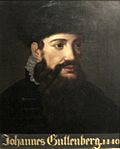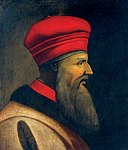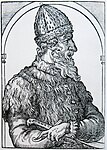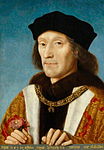15th century
This article needs additional citations for verification. (September 2022) |
| Millennium |
|---|
| 2nd millennium |
| Centuries |
| Timelines |
|
| State leaders |
| Decades |
| Categories: |
|
Births – Deaths Establishments – Disestablishments |

The 15th century was the century which spans the Julian calendar dates from 1 January 1401 (represented by the Roman numerals MCDI) to 31 December 1500 (MD).
In
The
in the later part of the century.The spices, wines and precious metals of the Bengal Sultanate[5] had attracted European traders to trade with Bengal, but the trade was subsequently lower, due to the rise of the Ottoman Empire, which introduced new taxes and tariffs against European traders. This had led to explorers like Christopher Columbus finding a route to reach India, which eventually reached the Americas. Explorers like Vasco da Gama, a Portuguese traveller, also found a route to reach to India from the African coast.
In
In
In the Americas, both the Aztec Empire and the Inca Empire reached the peak of their influence, but the voyages of Christopher Columbus and other European voyages of discovery in the Americas, beginning the European colonization of the Americas, changed the course of modern history.
Events
1401–1409

- 1401: Dilawar Khan establishes the Malwa Sultanate in present-day central India.
- 1402: Ottoman and Timurid Empires fight at the Battle of Ankara resulting in the capture of Bayezid I by Timur.
- Parameswara.[6]
- 1402: The settlement of the Canary Islands signals the beginning of the Spanish Empire.
- 1403–1413: Ottoman Interregnum, a civil war between the four sons of Bayezid I.
- 1403: The Yongle Emperor moves the capital of China from Nanjing to Beijing.[7]
- 1404–1406: Regreg War, Majapahit civil war of secession between Wikramawardhana against Wirabhumi.
- 1405: The Sultanate of Sulu is established by Sharif ul-Hāshim.
- 1405–1433: During the Ming treasure voyages, Admiral Zheng He of China sails through the Indian Ocean to Malacca, India, Ceylon, Persia, Arabia, and East Africa to spread China's influence and sovereignty. The first voyage, a massive Ming dynasty naval expedition ending in 1407, visited Java, Palembang, Malacca, Aru, Samudera and Lambri.[8]
- 1408: The last recorded event to occur in the Norse settlements of Greenland was a wedding in Hvalsey in the Eastern Settlement in 1408.
1410s
- Teutonic Knights.
- The last Welsh war of independence, led by Owain Glyndŵr.
- 1414: Khizr Khan, deputised by Timur to be the governor of Multan, takes over Delhi founding the Sayyid dynasty.
- conquest of Ceuta from the Moors marking the beginning of the Portuguese Empire.
- 1415: Battle of Agincourt fought between the Kingdom of England and France.
- 1415: Jan Hus is burned at the stake as a heretic at the Council of Constance.
- Ming Dynasty.[9]
- 1417: The East king of Sulu, Paduka Pahala, on their way home, suddenly died in Dezhou, a city in east China's Shandong province. The Yongle Emperor Zhu Di commissioned artisans to build a tomb for the king.[10]
- 1419–1433: The Hussite Wars in Bohemia.
1420s

- 1420: Construction of the Chinese Forbidden City is completed in Beijing.
- Kings of England since 1406.
- 1424: Deva Raya II succeeds his father Veera Vijaya Bukka Raya as monarch of the Vijayanagara Empire.
- 1425: Catholic University of Leuven (Belgium) founded by Pope Martin V.
- 1427: Reign of Itzcoatl begins as the fourth tlatoani of Tenochtitlan and the first emperor of the Aztec Empire.
- 1429: Joan of Arc ends the Siege of Orléans and turns the tide of the Hundred Years' War.
- 1429: Queen Suhita succeeds her father Wikramawardhana as ruler of Majapahit.[11]
1430s
- 1430: Rajah Lontok and Dayang Kalangitan become co-regent rulers of the ancient kingdom of Tondo.
- 1431
- occupation.
- .
- 26 March – The trial of Joan of Arcbegins.
- burned at the stake.
- Teutonic Knights and Švitrigaila sign the Treaty of Christmemel, creating anti-Polish alliance
- September – Battle of Inverlochy: Donald Balloch defeats the Royalists.
- .
- 16 December – Henry VI of Englandis crowned King of France.
- 1438: Pachacuti founds the Inca Empire.
1440s

- 1440: Eton College founded by Henry VI.
- Siberia Khanate, the Khanate of Kazan, the Astrakhan Khanate, the Crimean Khanate, and the Great Horde.
- Aztecs become the dominant power in Mesoamerica.
- Benin, and turns it into an empire.
- 1440: Reign of Moctezuma I begins as the fifth tlatoani of Tenochtitlan and emperor of the Aztec Empire.
- 1441: Jan van Eyck, Flemish painter, dies.
- .
- 1441: A civil war between the Tutul Xiues and Cocom breaks out in the League of Mayapan. As a consequence, the league begins to disintegrate.
- 1442: Leonardo Bruni defines Middle Ages and Modern times.
- Abdur Razzaqvisits India.
- King Sejong the Great publishes the hangul, the native phonetic alphabet system for the Korean language.
- 1444: The Albanian league is established in Lezha, Skanderbeg is elected leader. A war begins against the Ottoman Empire. An Albanian state is set up and lasts until 1479.
- 1444: Ottoman Empire under Sultan Murad II defeats the Polish and Hungarian armies under Władysław III of Poland and János Hunyadi at the Battle of Varna.
- Grand Duchy of Moscow at the Battle of Suzdal.
- 1446: Mallikarjuna Raya succeeds his father Deva Raya II as monarch of the Vijayanagara Empire.
- 1447: Wijaya Parakrama Wardhana, succeeds Suhita as ruler of Majapahit.[11]
- Saint Srimanta Sankardevawas born.
- Battle of Tumu Fortress.
1450s
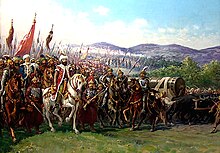
- 1450s: Machu Picchu constructed.
- 1450: Dayang Kalangitan became the Queen regnant of the ancient kingdom of Tondo that started Tondo's political dominance over Luzon.
- Lodhi dynasty
- 1451: Rajasawardhana, born Bhre Pamotan, styled Brawijaya II succeeds Wijayaparakramawardhana as ruler of Majapahit.[11]
- Constantine XI and the beginning of the Classical Age of the Ottoman Empire.
- 1453: The Battle of Castillon is the last engagement of the Hundred Years' War and the first battle in European history where cannons were a major factor in deciding the battle.
- 1453: Reign of Rajasawardhana ends.[11]
- Thirteen Years' War, Poland annexes Royal Prussia.
- 1455–1485: Wars of the Roses – English civil war between the House of York and the House of Lancaster.
- posthumously acquitted of heresy by the Catholic Church, redeeming her status as the heroine of France.
- 1456: The Siege of Belgrade halts the Ottomans' advance into Europe.
- 1456: Girishawardhana, styled Brawijaya III, becomes ruler of Majapahit.[11]
- 1457: Construction of Edo Castle begins.
1460s

- 1461: The League of Mayapan disintegrates. The league is replaced by seventeen Kuchkabal.
- 1461: The city of Sarajevo is founded by the Ottomans.
- 1461:
- Jasper Tudor, Earl of Pembroke in Wales.
- Earl of Warwick's army is defeated by a Lancastrian force under Queen Margaret, who recovers control of her husband.
- Edward IV of England.
- war of the Roses.
- 29 March – Battle of Towton: Edward IV defeats Queen Margaret to make good his claim to the English throne (thought to be the bloodiest battle ever fought in England).
- Edward IV, King of England (reigns until 1483).
- July – Byzantine general Graitzas Palaiologos honourably surrenders Salmeniko Castle, last garrison of the Despotate of the Morea, to invading forces of the Ottoman Empire after a year-long siege.
Political map of Europe in 1470 - Louis XI of France succeeds Charles VII of France as king (reigns until 1483).
- 1462: Sonni Ali Ber, the ruler of the Songhai (or Songhay) Empire, along the Niger River, conquers Mali in the central Sudan by defeating the Tuareg contingent at Tombouctou (or Timbuktu) and capturing the city. He develops both his own capital, Gao, and the main centres of Mali, Timbuktu and Djenné, into major cities. Ali Ber controls trade along the Niger River with a navy of war vessels.
- The Night Attack.
- Edward IV of England secretly marries Elizabeth Woodville.
- Marinid Sultan of Morocco Abd al-Haqq II.
- 1466: Singhawikramawardhana, succeeds Girishawardhana as ruler of Majapahit.[11]
- Black Sheep Turkoman leader Jahān Shāh.
- 1467–1615: The Sengoku period is one of civil war in Japan.
- Matthias Corvinus of Hungary. His mercenary standing army (the Black Army) had the strongest military potential of its era.
- Matthias Corvinus of Hungary conquers some parts of Bohemia.
- Muslim Sufis across the Indian subcontinent.
- Aztec Triple Alliance.
1470s
- 1470: The Moldavian forces under Stephen the Great defeat the Tatars of the Golden Horde at the Battle of Lipnic.
- 1471: The kingdom of Champa suffers a massive defeat by the Vietnamese king Lê Thánh Tông.
- 1472: Abu Abd Allah al-Sheikh Muhammad ibn Yahya becomes the first Wattasid Sultan of Morocco.
- .
- Novgorod.
- 1478: Reign of Singhawikramawardhana ends.[11]
- Wali Songo during the reign of Sultan Raden Patah.
- Matthias Corvinus of Hungarydefeated the Turks.
- 1479: JagatGuru Vallabhacharya Ji Mahaprabhu was born[12]
1480s
- Muscovy gained independence from the Great Horde.
- 1481: Spanish Inquisition begins in practice with the first auto-da-fé.
- Aztec Triple Alliance.
- Congo.
- 1483: The Jews are expelled from Andalusia.
- 1483: Pluto moves inside Neptune's orbit until July 23, 1503, according to modern orbital calculations.
- 1484: William Caxton, the first printer of books in English, prints his translation of Aesop's Fables in London.
- Matthias Corvinus of Hungary captured Vienna, Frederick III, Holy Roman Emperorran away.
- Battle of Bosworthand becomes King of England.
- 1485: Ivan III of Russia conquered Tver.
- Sangama Dynasty.
- 1486: Sher Shah Suri, is born in Sasaram, Bihar.
- Aztec Triple Alliance.
- 1487: Hongzhi Emperor ascends the throne, bringing Confucian ideology under his administration.
- 1488: Portuguese Navigator Bartolomeu Dias sails around the Cape of Good Hope.
1490–1500
- Askia (meaning "general") Muhammad. Askia Muhammad made Songhai the largest empire in the history of West Africa. The empire went into decline, however, after 1528, when the now-blind Askia Muhammad was dethroned by his son, Askia Musa.
- .
- Catholicism; 40,000–200,000 leave.
- 1492: Christopher Columbus landed in the Americas from Spain.
- 1493: Christopher Columbus landed on modern-day Puerto Rico.
- 1493: Leonardo da Vinci creates the first known design for a helicopter.
- 1494: Spain and Portugal sign the Treaty of Tordesillas and agree to divide the World outside of Europe between themselves.
- 1494–1559: The Italian Wars lead to the downfall of the Italian city-states.
- 1495: Manuel I of Portugal was succeeded as the king of Portugal (reigns until 1521).
- 1497–1499: Vasco da Gama's first voyage from Europe to India and back.
- 1499: Ottoman fleet defeats Venetians at the Battle of Zonchio.
- 1499: University "Alcalá de Henares" in Madrid, Spain is built.
- 1499: Michelangelo's Pietà in St. Peter's Basilica is made in Rome
- 1500: Islam becomes the dominant religion across the Indonesian archipelago.[13]
- Maynila, on the other side of the Pasig River shortly after taking over Tondo from its monarch, Lakan Gambang.[14]
- Sundanese Hindu hermit journeys throughout Java and Bali.[15]
- Archduke of Austria, and Holy Roman Emperor) was born.
- 1500: Guru Nanak begins the spreading of Sikhism, the fifth-largest religion in the world.
- 1500: Spanish navigator Vicente Yáñez Pinzón encounters Brazil but is prevented from claiming it by the Treaty of Tordesillas.
- 1500: Portuguese navigator Pedro Álvares Cabral claims Brazil for Portugal.
- Second Battle of Lepanto.
Gallery
-
Filippo Brunelleschi (1377–1446), regarded as one of the greatest engineers and architects of all time
-
Johannes Gutenberg (1400–1468), German inventor who introduced printing to Europe with his mechanical movable-type printing press
-
Skanderbeg (1405–1468), who led the Albanian resistance against the Ottoman Empire
-
Ivan III of Russia (1440–1505), Grand Prince of Moscow who ended the dominance of the Tatars in the lands of the Rus
-
Plantagenet dynasty
-
Tudor
Inventions, discoveries, introductions
- science and art.
- Rise of Modern English language from Middle English.
- Introduction of the noon bell in the Catholicworld.
- Public banks.
- Yongle Encyclopedia—over 22,000 volumes.
- Hangul alphabet in Korea.
- Scotch whisky.
- Psychiatric hospitals[clarification needed].
- Development of the woodcut for printing between 1400–1450.
- Movable type first used by King Taejong of Joseon—1403. (Movable type, which allowed individual characters to be arranged to form words, was invented in China by Bi Sheng between 1041 and 1048.)
- Although pioneered earlier in Korea and by the Chinese official .
- Johannes Gutenberg advances the printing press in Europe (c. 1455)
- Invention of the harpsichord c. 1450
- Arrival of Christopher Columbus to the Americas in 1492.
References
- ISBN 0-571-22185-8. (reviewed by Foster, Charles (22 September 2006). "The Conquestof Constantinople and the end of empire". Contemporary Review. Archived from the originalon 22 August 2009.
It is the end of the Middle Ages
- ^ Encyclopædia Britannica, Renaissance, 2008, O.Ed.
- ^ McLuhan 1962; Eisenstein 1980; Febvre & Martin 1997; Man 2002
- ^ Harvey 2005, p. 14.
- ISBN 978-81-8069-149-2.
Bengal [...] was rich in the production and export of grain, salt, fruit, liquors and wines, precious metals and ornaments besides the output of its handlooms in silk and cotton. Europe referred to Bengal as the richest country to trade with.
- JSTOR 608731.
- ^ "An introduction to the Ming dynasty (1368–1644)". Khan Academy. Asian Art Museum. Retrieved 29 September 2018.
- ^ Modern interpretation of the place names recorded by Chinese chronicles can be found e.g. in Some Southeast Asian Polities Mentioned in the MSL Archived 12 July 2012 at the Wayback Machine by Geoffrey Wade
- ^ "Thousands in China are descendants of an ancient Filipino king. Here's how it happened". Filipiknow. 24 March 2017.
- ^ "New Sulu King research book by Chinese author debuts in Philippines". Xinhuanet. Archived from the original on 16 August 2021.
- ^ a b c d e f g Ricklefs (1991), page 18.
- ^ "Shri Mahaprabhuji Shri Vallabhacharyaji Biography | Pushti Sanskar". pushtisanskar.org. Retrieved 2 June 2023.
- ^ Leinbach, Thomas R. (20 February 2019). "Religions". Encyclopedia Britannica. Retrieved 23 February 2019.
- ISBN 978-94-017-8682-9.
- ^ Noorduyn, J. (2006). Three Old Sundanese poems. KITLV Press. p. 437.
Sources
- Langer, William. An Encyclopedia of World History (5th ed. 1973); highly detailed outline of events online free
- ISBN 1-85984-108-2
- ISBN 0-521-29955-1
- Tolley, Thomas (2001). "Eyck, Barthélemy d'". In Hugh Brigstocke (ed.). The Oxford Companion to Western Art. Oxford: Oxford University Press. ISBN 0-19-866203-3.
- Harvey, L. P. (16 May 2005). Muslims in Spain, 1500 to 1614. Chicago: University of Chicago Press. ISBN 978-0-226-31963-6.
- ISBN 978-0-7472-4504-9
- ISBN 978-0-8020-6041-9



